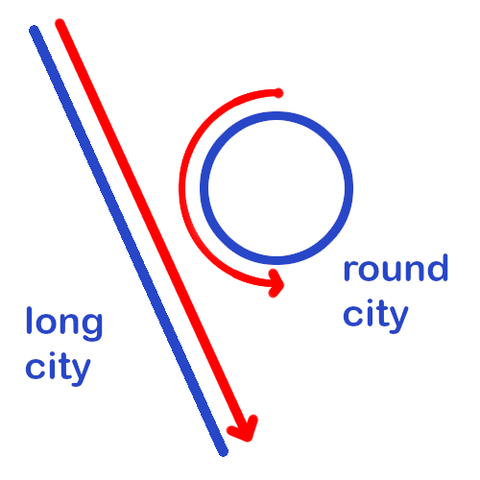
Twitter/CICSaudi/Screenshot
- Could the next big thing be a city built in a very long, narrow line?
- Saudi Arabia’s idea sounds cool, but even a “hollow” circular city of this kind makes more logistical sense.
- Cities grow based on what people need, like housing close to work or schools.
Saudi Arabia has shared a wild idea to build a city without roads, where 1 million people will live in one long line along a core train track.
Mohammed bin Salman bin Abdulaziz Al Saud, the Crown Prince of Saudi Arabia, said in his Apple-like announcement that no one will live more than a “5-minute walk” from the services and shops they need, and the train line that anchors the line city will take just 20 minutes to travel its entire over 105-mile length.
THE LINE, as bin Salman is calling the ambitious project, will “preserve 95 [percent] of nature … with zero cars, zero streets, and zero carbon emissions,” he said in a press release. The city will be powered by 100 percent clean energy and artificial intelligence, while “an estimated 90 [percent] of available data will be harnessed to enhance infrastructure capabilities far beyond the 1 [percent] typically utilized in existing smart cities.
This content is imported from Twitter. You may be able to find the same content in another format, or you may be able to find more information, at their web site.
Technological traits aside, can bin Salman’s core concept—a 105-mile city built in a straight line—actually work? Let’s look at some math, game design, and even literature to consider the feasibility.
This content is imported from embed-name. You may be able to find the same content in another format, or you may be able to find more information, at their web site.
If the city of Chicago, for example, were rearranged into one single line in this same way, at about the density of 1 million residents per 100 miles, the line would stretch almost to St. Louis—a distance of just under 300 miles. If the entire Chicagoland area were on such a line, it would reach to Jacksonville, Florida. This is an entirely new paradigm for building settlements for people.
Or … is it? Does a line make sense for a city, and we’ve just never thought it through?
First, the idea of one very long, narrow city does exist, at least in fiction. In Arrival author Ted Chiang’s story “Tower of Babylon“, the titular tower extends into the sky. “Were the tower to be laid down across the plain of Shinar, it would be two days journey to walk from one end to the other,” Chiang writes.
That’s approximately 40 to 60 miles high—enough to nearly reach the Kármán Line, the generally recognized border of outer space. But this is still far shorter than our city “line.”
In Chiang’s story, people who live along the tower’s height must climb over a month’s worth of stairs. It’s implied that this journey is almost always just one way.
🛴 The Best Electric Scooters for Getting Around Your City
So what if we did lay the “tower” on its side to make one extraordinary line?
The idea of being just 5 minutes from everything you need sounds good. It’s familiar to anyone who’s played a game like Pocket City or even Roller Coaster Tycoon, where the automated populations are happiest when they’re near their favorite facilities. But as Middle East Eye points out, it isn’t clear “how or why a city built in a straight line made it easier for people to walk to their desired destinations compared to a conventionally shaped city.”
It also isn’t clear why a single line is better than a circular train line with a ring of human settlement surrounding it. Yes, being 20 minutes from the other side of town is good, but residents of a “wagon wheel” would never be further than just 10 minutes away, and trains could run freely in one direction continuously. The amount of area surrounding the train line would still be the same for people seeking to build homes and businesses.
Does a “hollow” shape like this—a line or an empty circle—make more sense than how our cities are now, packed solid and sprawling? Presumably, this eliminates the need for roads by simply limiting the depth to which the population can settle along a particular axis. If people never take more than a 5-minute walk from the train, they’ll never need a road.
But there are structural problems with this, like the fact that highways carry more overland cargo than people. People won’t want to carry cargo onto or off of a train, even if it’s “only” to their shops 5 minutes away. How will they ever pack up and move? How will disabled people navigate the city?
Residents already do impromptu geometry when they decide where to live. People who can withstand a longer commute can live farther away from city centers, in housing that likely costs less. Others simply must withstand the commute because they can’t afford to live closer.
In a linear city with no roads, it’s easy to imagine “front-row” housing taking a hugely premium price, while people must somehow lug goods to and from their more affordable homes in the next rows.
Over 105 miles long sounds like a lot, but for a million people, that’s still about two people per foot of length. Able-bodied people might prefer to build even more rows that are a longer walk away, but closer to the place where they work, causing buildup around places that have the most business and service activity. Maybe it makes sense to extend a small train line to the end of that new area of settlement. And … now we’re just building a regular city. 🤷🏻♂️
This content is created and maintained by a third party, and imported onto this page to help users provide their email addresses. You may be able to find more information about this and similar content at piano.io














More Stories
How News Technology is Shaping Public Opinion
Exploring Ethics in News Technology Practices
News Technology: Enhancing Audience Engagement